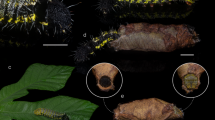Abstract
Six new genera, three tribes and one subfamily are added to the list of known hosts for the enigmatic endoparasitic fungus Myrmicinosporidium Hölldobler. Aphaenogaster senilis, Cataglyphis hispanica, Crematogaster auberti, Goniomma hispanicum, Messor barbarus, Tapinoma nigerrimum and Tapinoma simrothi were collected from olive groves and detected as infected with spores of the fungus. Pheidole pallidula and Tetramorium semilaeve were also found to be infected. The finding of seven hosts (seven genera, three subfamilies) from a single olive grove is an evidence that the fungus has a phylogenetically wide host spectrum and is, therefore, a generalist microparasite. Portugal is also a new country for Myrmicinosporidium.
Similar content being viewed by others
References
Birkhofer K., Martijn Bezemer T., Bloem J., Bonkowski M., Christensen S., Dubois D., Ekelund F., Fließbach A., Gunst L., Hedlund K., Mäder P., Mikola J., Robin C., Setäla H., Tatin-Froux F., Van der Putten W.H. and Scheu S. 2008. Long-term organic farming fosters below and aboveground biota: Implications for soil quality, biological control and productivity. Soil Biol. Biochem. 40: 2297-2308
Bolton B. 2003. Synopsis and classification of Formicidae. Mem. Am. Entomol. Inst. 71: 1-370
Boomsma J.J., Schmid-Hempel P. and Hughes W.O.H. 2005. Life histories and parasite pressure across the major groups of social insects. In: Insect Evolutionary History (Fellowes M.D.E., Holloway G.J. and Rolff J., Eds), Royal Entomological Society, pp 139-175
Brady S.G., Schultz T.R. and Fisher B.L. 2006. Evaluating alternative hypotheses for the early evolution and diversification of ants. Proc. Natl Acad. Sci. U.S.A. 103: 18172-18177
Buschinger A., Beibl J., D’Ettorre P. and Ehrhardt W. 2004. Recent records of Myrmicinosporidium durum Hölldobler, 1933, a fungal parasite of ants, with first record North of the Alps after 70 years. Myrmecol. Nachr. 6: 9-12
Buschinger A. and Kleespies R.G. 1999. Host range and host specificity of an ant-pathogenic gregarine parasite, Mattesia geminata (Neogregarinida: Lipotrophidae). Entomol. Gen. 24: 93-104
Buschinger A. and Winter U. 1983. Myrmicinosporidium durum Hölldobler 1933, Parasit bei Ameisen (Hym., Formicidae) in Frankreich, der Schweiz und Jugoslawien wieder aufgefunden. Zool. Anz. 210: 393-398
Collingwood C.A. and Prince A. 1998. A guide to ants of continental Portugal (Hymenoptera: Formicidae). Bol. Soc. Port. Entomol., Supl. 5: 1-49
Cremer S., Armitage S.A.O. and Schmid-Hempel P. 2007. Social immunity. Curr. Biol. 17: R693-R702
Espadaler X. 1982. Myrmicinosporidium sp., parasite interne des fourmis. Etude au MEB de la structure externe. In: La Communication chez les Sociétés d’Insectes (De Haro A. and Espadaler X., Eds). Coll. Int. U.I.E.I.S., Barcelona, pp 239-241
Espadaler X. 1997. Pheidole williamsi (Hymenoptera, Formicidae) parasitized by Myrmiciniosporidium durum (Fungi) on San Salvador Island (Galápagos Islands). Sociobiology 30: 99-101
Espadaler X. and Santamaria S. 2012. Ecto- and endoparasitic fungi on ants from the Holarctic region. Psyche 2012 (168478): 1-10
García F. and Espadaler X. 2010. Nuevos casos y hospedadores de Myrmicinosporidium durum Hölldobler, 1933 (Fungi). Iberomyrmex 2: 3-9
Hole D.G., Perkins A.J.,Wilson J.D., Alexander I.H., Grice P.V. and Evans A.D. 2005. Does organic farming benefit biodiversity? Biol. Conserv. 122: 113-130
Hölldobler K. 1927. Über merkwürdige Parasiten von Solenopsis fugax. Zool. Anz. 70: 333-334
Hölldobler K. 1929. Über eine merkwürdige Parasitenerkrankung von Solenopsis fugax. Z. Parasit. 2: 67-72
Hölldobler K. 1933. Weitere Mitteilungen über Haplosporidien in Ameisen. Z. Parasit. 6: 91-100
Kanizsai O. 2010. Myrmicinosporidium durum, egy különös hangyapatogén. Proc. 3rd Carpathian Basin Myrmecol. Symposium: 5, Senete, Romania
Moreau C.S., Bell C.D., Vila R., Archibald S.B. and Pierce N.E. 2006. Phylogeny of the ants: Diversification in the age of angiosperms. Science 312: 101-104
Pereira R.M. 2004. Occurrence of Myrmicinopsoridium durum in red imported fire ant, Solenopsis invicta and other new ant hosts in eastern United States. J. Inv. Pathol. 84: 38-44
Reber A. and Chapuisat M. 2011. Diversity, prevalence and virulence of fungal entomopathogens in colonies of the ant Formica selysi. Insect. Soc. doi 10.1007/s00040-011-0209-3
Sánchez-Peña S.R., Buschinger A. and Humber R.A. 1993. Myrmicinosporidium durum, an enigmatic fungal parasite of ants. J. Inv. Pathol. 61: 90-96
Schmid-Hempel P. 1998. Parasites in Social Insects. Princeton University Press, Princeton, NJ
Seifert B. 1992. A taxonomic revision of the Palaearctic members of the ant subgenus Lasius s. str. (Hymenoptera: Formicidae). Abh. Ber. Naturkundemus. Görlitz 66: 1-66
Ugelvig L.V. and Cremer S. 2007. Social prophylaxis: group interaction promotes collective immunity in ant colonies. Current Biology 17: 1967-1971
Ugelvig L.V., Kronauer D.J.C., Schremp A., Heinze J. and Cremer S. 2010. Rapid anti-pathogen response in ant societies relies on high genetic diversity. Proc. R. Soc. B 277: 2821-2828
Acknowledgments
Comments by two reviewers added value to the manuscript. This study was financially supported by FEDER Funds through the Programa Operacional Factores de Competitividade—COMPETE and National Funds through the FCT—Fundação para a Ciência e Tecnologia, within project PTDC/AGR-PRO/111123/2009: The use of biological indicators as tools for assessing the impact of agricultural practices in the sustainability of olive groves. X.E. is currently supported by Ministerio de Ciencia y Tecnología MCYT-FEDER grant CGL2010-18182.
Author information
Authors and Affiliations
Corresponding author
Rights and permissions
About this article
Cite this article
Gonçalves, C., Patanita, I. & Espadaler, X. Substantial, and significant, expansion of ant hosts range for Myrmicinosporidium Hölldobler, 1933 (Fungi). Insect. Soc. 59, 395–399 (2012). https://doi.org/10.1007/s00040-012-0232-z
Received:
Revised:
Accepted:
Published:
Issue Date:
DOI: https://doi.org/10.1007/s00040-012-0232-z




